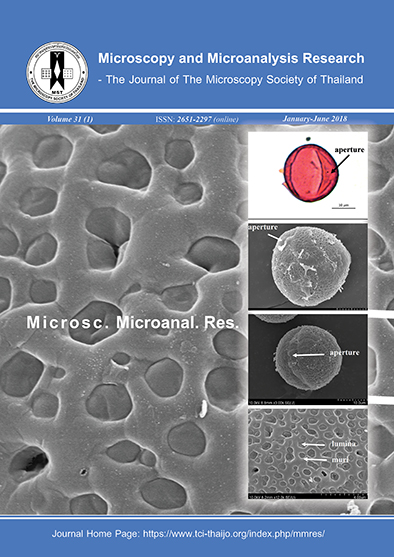Pollen Characteristics of Some Species in the Genus Bacopa
Main Article Content
Abstract
Plants in the genus Bacopa are important herbs, which makes them suitable to be studied about pollen morphology because it can be used to identify medicinal plants. Pollens of two Bacopa species were examined under light and scanning electron microscopes. The two species were similar in their aperture type, shape, and exine sculpturing. The aperture type of both species is compound aperture and tricolporate. The shapes of polar view are circular and semi-angular. The shapes of equatorial view are spheroidal, oblate-spheroidal and prolate-spheroidal. On the other hand, the species differed in their number of lumina. The exine sculpturing appears to have several lumina. It was found that the number of lumina on the exine sculpturing of B. monnieri was larger than on B. caroliniana. As a result, the morphological characteristics of the pollen can be used for species identification of this genus.
Article Details
References
2. B.L. Gabriel, Biological Scanning Electron Microscopy, Van Nostrand Reinhold Publishing, New York, 1982.
3. C. D. K. Cook, Aquatic Plant Book, SPB Academic Publishing, Amsterdam/New York, 1996.
4. D.A. Willard, C.E. Bernhardt, L.Weumer, S.R. Cooper, D. Gamez, J. Jensen, Atlas of pollen and spore of the Florida Everglades, Palynology, 2004, 28, 175-226.
5. D. S. Correll, H.B. Correll, Aquatic and Wetland Plants of Southwestern United States Volume II, Stanford University Press, California, 1975.
6. G. Erdtman, Pollen Morphology and Plant Taxonomy, Angiosperm, third ed., Hafner Pub.Comp, New York, 1972.
7. National Parks Flora and Fauna, Bacopa monnieri (L.) Wettst., Singapore, Available from: https://florafaunaweb.nparks.gov.sg/Special-Pages/plant-detail.aspx?id=6847. November 13, 2017.
8. N. El-Husseini, E. Shamso, Pollen atlas of the flora of Egypt, species of scrophulariaceae, Taeckholmia, 2002, 22, 65-79.
9. P.D. Moore, J.A. Webb, M.E. Collinson, Pollen Analysis, Blackwell Scientific Publications, Oxford, 1991.
10. P. Hoen, Glossary of Pollen and Spore Terminology. Laboratory of Palaeobotany and Palynology, Utrecht University, Budapestlaan, Netherlands. second and revised ed., Available from: http://www.bio.uu.nl/~palaeo/glossary/glos-tin.htm. December 4, 2007.
11. R. E. Weaver, P.J. Anderson, Botany section, TRI-OLOGY, 2007, 46, 6, 1-11.
12. T. Peth-Nui, J. Wattanathorn, S. Muchimapura, T. Tong-Un, N. Piyavhatkul, P. Rangseekajee, K. Ingkaninan, S. Vittaya-areekul, Effects of 12- week Bacopa monnieri consumption on attention, cognitive processing, working memory, and functions of both cholinergic and monoaminergic systems in healthy elderly volunteers, Evidence-Based Complementary and Alternative Medicine, 2012, 1-10.
13. W.R. Baker, New South Wales Flora Online Available from http://plantnet.rbgsyd.nsw.gov.au/floraonline.htm, 1992. October 24, 2017.
14. Y. Hong, H. Yang, C.Jin, M. A. Fischer, N. H. Holmgren, R.R. Mill, Scrophulariaceae, Flora of China, Available from: http://www.efloras.org/florataxon.aspx?flora_id=2&taxon_id=10811. October 28, 2017.
15. Y. Iwanami, T. Sasakuma, Y. Yamada, Pollen: Illustrations and Scanning Electronmicrographs, Kodansha, Tokyo, 1988.


